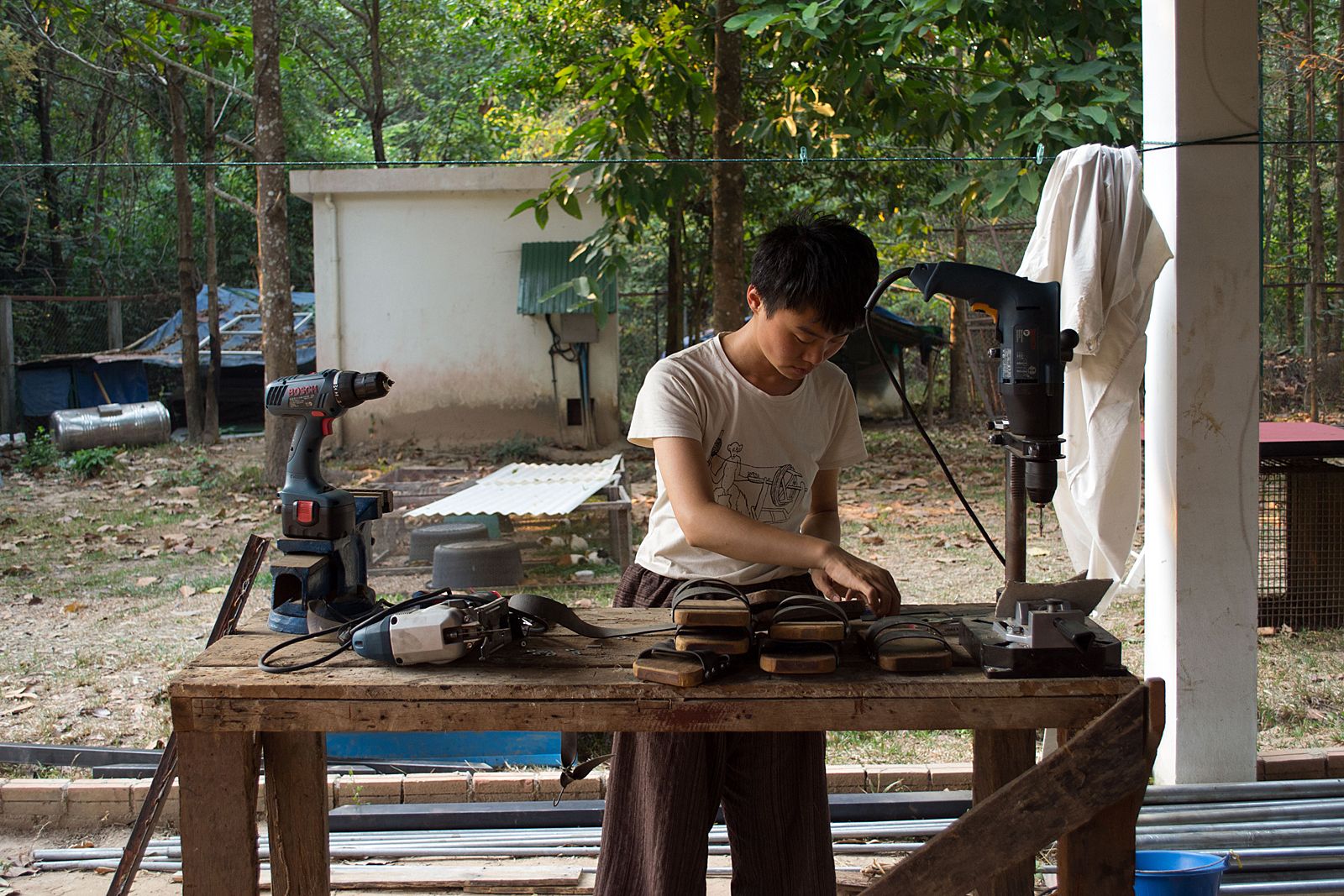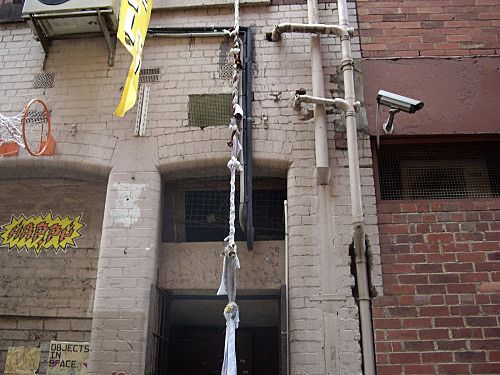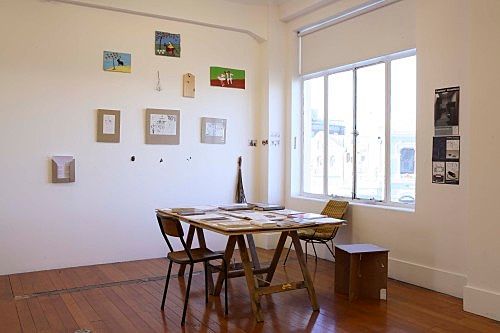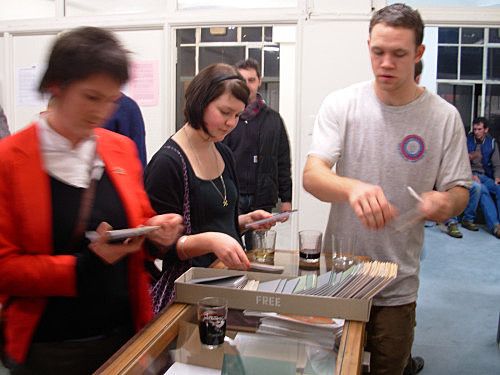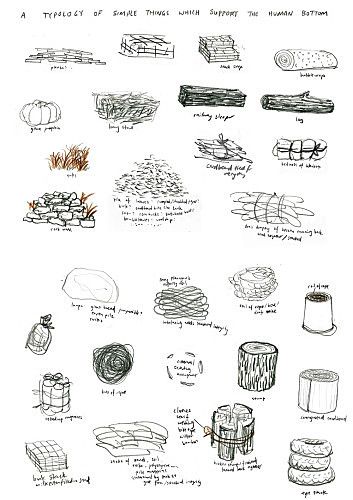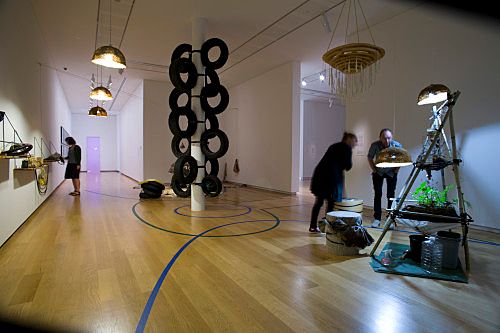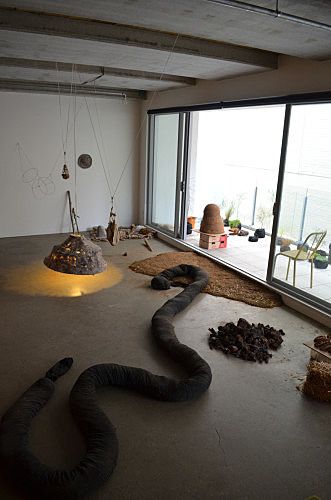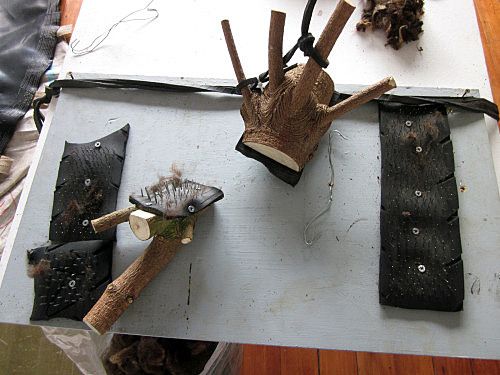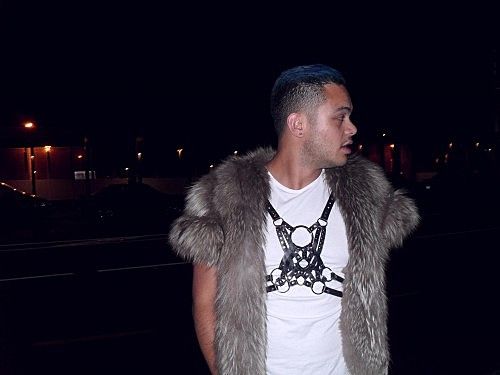In The Wake of Catastrophe: Xin Cheng's Art Survival Kit
Auckland based-artist Xin Cheng uses the hardiness and handiness of found materials to tease out a kind of playful 'living in the ruins' - thrifty and unpackaged solutions in an overprocessed world. Daniel Satele talks to her about growing up on Enid Blyton and showing work for the first time.
[caption id="attachment_9384" align="aligncenter" width="500"] Escape Route for TCB Inc., part of “the (self-initiated Artist funded) Second (fourth) Y2K Melbourne Biennial of Art (& design)”, Melbourne, Australia, 2008. Photo: Christopher L. G. Hill.
Bed sheets and scrap fabric, tied in the same manner as prisoner escape ropes, hung from the gallery toilet window down to the street below. The gallery had no fire escape route.[/caption]
For my money, Xin Cheng’s contribution was the absolute highlight of the group exhibition Freedom Farmers, Auckland Art Gallery’s largest survey of contemporary New Zealand art in 25 years. The exhibition’s premise was an exploration of utopianism (and the corresponding themes of sustainability and artistic freedom), viewing artists as innovators and “creative leaders” – and Xin offered what was probably the most genuine response. She assembled a range of recycled and permacultural items, presented almost as if in a showroom or an expo stall. However, the basketball court markings on the floor invoke the rec-hall-cum-evacuation-centre of Katrina, Fukushima, and Christchurch - the topsy-turvy state of exception we encounter in catastrophe’s wake. The elements combine to form a quasi-humourous post-apocalyptic scenario, with a touch of the anachronistic absurdity of The Flintstones and a hint of the survivalist melodrama of Tomorrow When the War Began.
Xin’s work often crosses the expected boundaries between art and the functional demands of everyday life. For example, her 2013 publication of a “selection of recipes for making food without much equipment” is exactly what it claims to be. If Xin’s evident interest in making useful art sounds disturbingly idealistic to cynical readers, let me hasten to add that her work’s implicit optimism is tempered with a radical non-prescriptiveness. Her pieces insist that it is a resourceful, adaptive and playful approach to the future we need, over and above any particular set of instructions. Indeed, it is the subtle humour of Xin’s work that tells us we’re dealing not with mere fantasy, but a rigorous engagement with the always unpredictable future; for if the past’s outmodedness looks ridiculous in hindsight, we can expect any authentic glimpse into the future to provoke a laugh too. In other words, when Armageddon comes, I want to lodge at Xin’s bunker.
[caption id="attachment_9385" align="aligncenter" width="500"] Being Resourceful In Various Situations, part of "Article 27", curated by Richard Dale, catalysed by the New Zealand Human Rights Commission, The Physics Room, Christchurch, 2009. Photo: Mark Gore.
A reading room and a collection of objects, books and instructions on things made in impoverished and improvising situations, such as informal street modifications, prisoners’ inventions and community initiatives which utilise making as a social glue.[/caption]
Can you tell us a little about your childhood and adolescence?
Most of my childhood in China was spent practising arithmetic and procrastinating over writing the weekly essays in Chinese. A few of my friends had a shared passion for Sherlock Holmes and Enid Blyton's Secret Seven series. We dreamt of going on adventures, solving mysteries and self-publishing books about them. One of my fondest memories was making a swing by tying a thick rope to a tree in the courtyard where I lived. It was exhilarating to realise that it was possible to make things myself, and it worked!
My adolescence was coloured by the challenges of moving to New Zealand, being very shy and feeling unsure of myself. I wanted to go to art school but I was also very good at science. I ended up studying biology and psychology before pursuing art, which I feel rather thankful for now, as that gave me a wider perspective.
Where would your dream residency be located and what would be its terms?
Somewhere where people still live in close connection to the land. The residency would not be restricted to artists but people from a wide range of fields e.g. permaculture gardeners, anthropologists, yogis, ecologists, nomads, architects, chefs, designers etc. The focus will be on sharing divergent approaches, ways of being in this world, feeling, thinking and doing together. In recognition of the long gestation period of works, there will be no pressure for immediate results at the end of the residency, but a chance to return at a later stage to develop the projects.
How did it feel the first time you showed work in public? Does it feel different now that you've done it more, or does it still feel the same?
The first time I showed work in public was in 2006, when Daniel Munn invited me to be a part of a group proposal for the artist-run-space rm103 (now RM). I agreed without knowing what I was going to do. Then as the opening drew closer a few strands of my interests came together, and I ended up making Free Books, which I am still very happy about, after all those years.
[caption id="attachment_9386" align="aligncenter" width="500"] "Free Books", rm103, Auckland, 2006. Photo: Kylie Duncan.
Free for the visitors of rm103: one hundred blank notebooks made from scrap paper and old folders salvaged from the university library photocopy room, French-folded and stapled during the artist's free time working as a gallery minder.[/caption]
There was a lot of self-doubt, stress and hard-work leading up to the opening, then a feeling of elation when the work was finally complete. I have done a lot more shows since then, but I still go through the same turbulent psychological process, although I have learnt to stress less and expect the initial feelings of uncertainty, and trust that things will come together eventually.
What is the hardest thing about being an artist?
Overcoming my own inertia and having the courage to run with my ideas, especially the ones that appear flaky at initially. Sol LeWitt had some sage advice in regard to this:
I have much confidence in you and even though you are tormenting yourself, the work you do is very good. Try to do some BAD work – the worst you can think of and see what happens but mainly relax and let everything go to hell – you are not responsible for the world – you are only responsible for your work – so DO IT. And don’t think that your work has to conform to any preconceived form, idea or flavor. It can be anything you want it to be. But if life would be easier for you if you stopped working – then stop. Don’t punish yourself. However, I think that it is so deeply engrained in you that it would be easier to DO!
[caption id="attachment_9387" align="aligncenter" width="353"] A Typology of Forms that Hold up the Human Bottom, drawing published in "Temporary housing + shelter", split/fountain & Whatever Press, Auckland & Tokyo, 2012.[/caption]
What do you think is the most valuable thing about art?
The optimism that crazy ideas can be realised - one just have to pursue them. Actually, this is can be applied to the rest of life as well. The Follow Sam education trail project I volunteered in last year in Cambodia was a good example - it began as an idea by Nadine Esche, a design and art student from Germany. Over two years she fundraised and gathered a team of companions for the project. We lived in the jungle for two months building the trail. Many things could have stopped the project from reaching fruition - inertia is comfortable, doubt is pervasive - but it got there, which was the amazing thing.
I really like what Morrie Schwartz, a sociologist, said in the book "Tuesdays with Morrie": "You have to be strong enough to say if the culture doesn't work, don't buy it. Create your own" (p35), and "Build a little community of those you love and who love you" (p155). Over the last few years I realised that people are the most precious things one can encounter. Through the activities I have been involved in, whether organising projects for other people, showing my own work, or research, I have been very fortunate to have come across many inspiring people and ways of running projects, often with very limited resources. It is heartening to see what miraculous things the human spirit of improvisation and resourcefulness can achieve - although that is not restricted to art, of course.
[caption id="attachment_9388" align="aligncenter" width="500"] "Propositions", mixed media installation, part of "Freedom Farmers", curated by Natasha Conland, Auckland Art Gallery, Auckland, 2013. Photo: Jennifer French.[/caption]
You’ve just been told you are going to be stranded on a desert island with three other artists/thinkers/scientists for the next twenty years, but you get to choose who the three people will be. Who do you choose?
Bernard Rudofsky, Zhuangzi, Jane Goodall.
What projects are you working on over the next 12 months?
I've been collaborating with the inspiring Chris Berthelsen on a number of making do walks and workshops that savour the simple pleasures of practical experimentation with resources at hand and the environment as given. We are currently organising an activity for the "distracted workshop" by split/fountain at the 26th International Biennial of Graphic Design Brno, Czech Republic. After that we would like to work with some children and schools in Auckland and Opotiki, and find opportunities to offer up our mental and physical skills into the re-shaping of shared spaces (dear reader, please get in touch if you know any!).
Later in May I'll be returning to Cambodia to do a residency with Sa Sa Art Projects in Phnom Penh, thanks to Asia New Zealand. I will continue my research into the make-shift constructions I had seen there last year, possibly accompany the makers at work and do a couple of projects with the school that Sa Sa runs.
[caption id="attachment_9389" align="aligncenter" width="331"] Installation view of "Sustenance" at split/fountain, Auckland, 2012. Photo: Asumi Mizuo, courtesy of split/fountain.[/caption]
Incidentally, between writing about my "dream residency" and revising this text for publication, I got accepted into a residency with Utopiana in Geneva, Switzerland. It has a particular focus on ecology, permaculture (including a community urban garden!) and social processes. There is an associated research group called Plantopic, and I am looking forward to working with them and the local community later this year. On the way back home, I would like to do more couchsurfing and nomadic wanderings to continue my ongoing research about ways of being in this world.
I'll be updating my website if you are interested: http://xin-cheng.info.
[caption id="attachment_9390" align="aligncenter" width="500"] Carding tools for processing raw fleece to make felt, made from salvaged materials during "Gleaners Garden", Enjoy Summer Residency with Kirsten Dryburgh, Wellington, 2014. Photo: Xin Cheng.[/caption]
